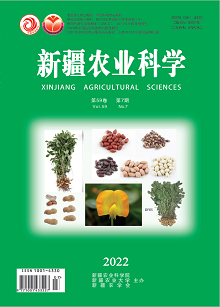【Objective】 The objective of this study is to explore the physiological response of 9 grape rootstocks to saline-alkaline stress at seedling stage and evaluate the tolerance capacity of grapes rootstocks to complex saline-alkaline stress and to screen salt-tolerant accessions for cultivation of salt-alkali lands and provide theoretical basis for the application of grape rootstocks in this kind of field. 【Methods】 The 9 rootstocks(SO4,5BB,3309M,110R,101-14 MG,V.riparia‘Hean-7', St.George,5C and 1103P) were cultivated in pots in a controlled environment chamber,two neutral salt(NaCl and Na2SO4)and one alkali salts(NaHCO3)were mixed with mole ratio of 1:2:1 to simulate typical saline-alkaline stress,the solution supplemented with 100 mmol/L saline-alkaline mixture was as the treatment,the water without exogenous saline-alkaline was used as the control.After that, plant growth,photosynthetic characteristics,leaf and root physiological indexed were measured.The saline-alkaline resistance of rootstocks accessions was evaluated by principal component analysis(PCA)and clustering analysis(CA). 【Results】 The results showed that the net photosynthetic rate of 5BB,110R,5C,101-14MG and 1103P decreased significantly under mixed salt-alkali stress treatment(100 mmol/L,NaCl∶Na2SO4 ∶NaHCO3=1∶2∶1),Net photosynthetic reduction of 110R,5C,101-14MG,1103P were larger than those of others,stomtal conductance reduction of 110R,5C,1103P,St. George were larger than those of others,the same as intercellular carbon dioxide concentration of 110R,5C,1103P,St. George.Chlorophyll mass fraction,weight of a single leaf,plant dry weight of shoots,root dry weight,total root length,root surface area,root volume and root vigor were significantly decreased.Chlorophyll mass fraction of V.riparia‘Hean-7' was less than those of others,growth indicators of V.riparia‘Hean-7' and 5BB were less than those of others,root growth index of V.riparia‘Hean-7' and 3309M were less than those of others,root vigor of 3309M,V.riparia‘Hean-7' and 101-14MG were less than others,all less than 30%,Other indicators varied from species to species,relative water content reduction of 1103P was maximum,the relative electrical conductivity and MDA reduction of 33309M and 101-14 were more than others,the relative electrical conductivity and MDA of V.riparia‘Hean-7' and 5C changed mildly.Principal component analysis was used to analyze 11 indicators tolerance of mixed saline-alkaline coefficients with different rootstocks,and the 11 individual indicators were converted into 5 independent of each other and comprehensive indicators,representing 93.315% of the complete information.The 9 grape rootstocks accessions were sorted into strongly tolerant to saline-alkaline stress,medium tolerance and lower tolerance groups based on principal component analysis(PCA)and clustering analysis (CA). 【Conclusion】 V.riparia‘Hean-7' is strongly tolerance to saline-alkaline stress,5BB,5C, St. George and 3309M are of medium tolerance,SO4, 1103P, 101-14MG and 110R have the characteristics of lower tolerance.

